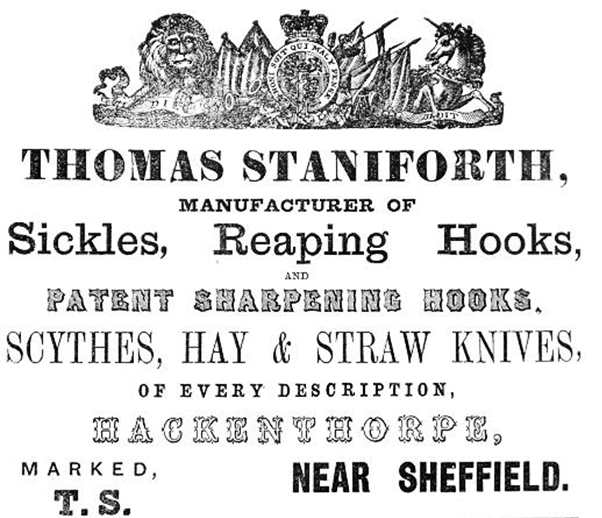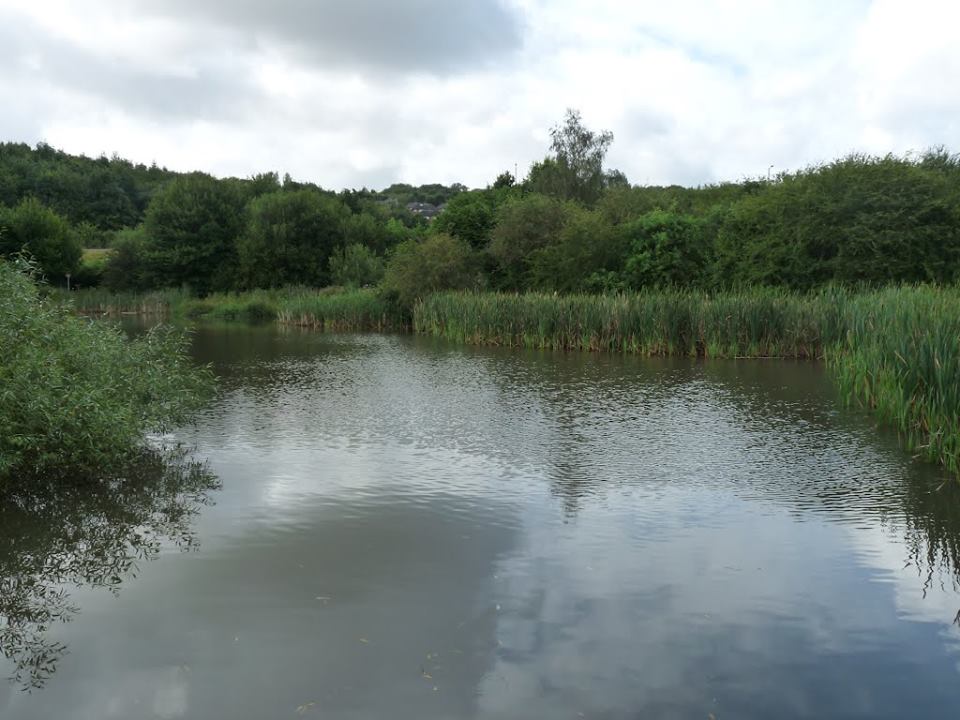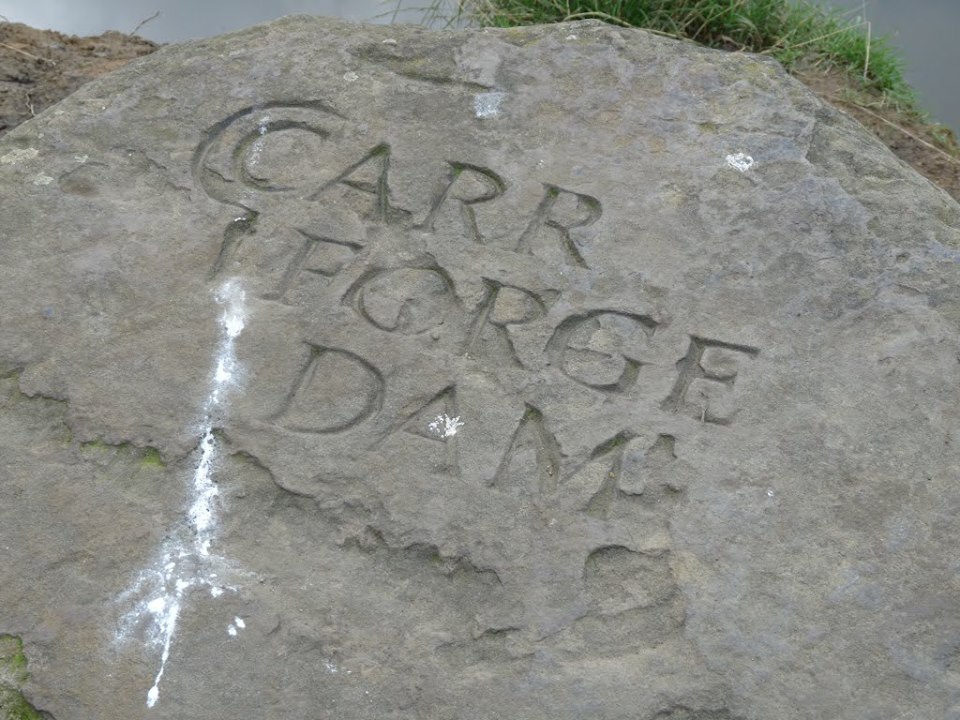
Thomas Staniforth & Co. Sickle works at Hackenthorpe.
 Carr Forge, 2012
Carr Forge, 2012
Carr Forge was a dam located on the Shire Brook, on the boundary between the counties of Derbyshire and Yorkshire. Historically the site was used for the grinding of Sickles and Scythes.
Many sources have been used to put this article together, including the extensive research published by the late T.L Platts, as well as the late Rosamund Du Cane.
In 1316, the Shirebrook is reffered to as 'Mill Dyke' which tells us that as early as the 14th Century, the stream was being used as a power source. The waterwheel used at this time is likely the same that is later referred to as 'cutlers wheel' and then the Carr Forge Wheel.
deed dated 4th October 1316 – Grant by Merjoria, late wife of Robert de Craven dwelling in Handisworth Wodehousis to John son of Nicholas de Astona, of two acres of meadow in the meadows of Handisworth Wodehousis in le Brodehing between the meadow of John de Hakinthorp and that of William de Birlaystone, and abutting at one end on the meadow of John de Hakimthorp and that of Richard de Marcham and at the other end on the mill dike (see York. Arch. Journ. Vol 13 p74).
The Roll of Lay Subsidy for 1378-9 for Sheffield and Handsworth reads "Thomas Byrlay and Margareta vx ejus cottelar vjd" (6d tax). This was a time when men would adopt the name of the place they lived as a surname. It seems very likely that if Thomas Byrlay (Birley), cutler was of Birley and the wheel he operated was located in the same place, it would have been located on the Shirebrook.
In other early records related to the area, we see that the Hobson family had a hall with 140 acres, which he most likely rented from Mr. Lynacre. The land included Tongue Meadow Knife Wheel, as well as many fields around the Carr Forge area.
Christopher Chapman was granted a trade-mark on May 3rd 1568, as can be seen in the records of the Sheffield Company of Cutlers. Christopher was a tenant of James Lynacre, paying three shillings rent for the half year for the Cutlers Wheel. Again this would have been Carr Forge.
By 1726, the wheel was being used by John Newbould. He was paying ten shillings rent to the Lord of Beighton Manor for the use of Scythe Making.
In 1736, Samuel Staniforth was paying ten shillings rent for water to the scythe wheel on Birley Moor (Carr Forge).
On December 25th 1761 Mrs. Inkersall leased the Scythe mill and dam for 21 years at twelve shillings and sixpence p.a. This lease appears to have been renewed as the Fairbanks Plan of Waterwheels on the Shirebrook, drawn in 1819 shows that the Inkersalls were still in possession. On this map, William Inkersall is recorded as being the occupant of the 'Scythe Wheel'.
 Carr Forge Dam Marker Stone, 2012
Carr Forge Dam Marker Stone, 2012
The Inkersall family resided at Inkersall House in Hackenthorpe, and are likely from Woodhouse prior to arriving in the village. The family had a growing scythe business, with George Inkersall buying over a thousand pounds worth of iron in 1763/4 from Carburton Forge near Wellbeck, and was described as being their biggest customer.
By 1818, the Napoleonic wars had come to an end and we see evidence of Thomas Staniforth applying for a new lease on the Carr Forge wheel, which at this time was owned by the Inkersall family. It seems there was some issues with William Inkersall, the owner at the time, who claimed the wheel had been built/rebuilt by his father George Inkersall. Thomas put in a successful application to lease the wheel however we see evidence of Thomas writing to the Earl Manvers agent, Mr Pickin explaining that Mr. Inkersall was refusing to sign the required receipts, and that he believed that Mr. Inkersall would write to the Earl Manvers claming that the ‘Wheel has been taken from him and is now let to another person for less value than he would give…Tho he dies not know exactly how much I do pay’. He was also claiming reinbursements for fencing that had been done.
Mr Pickin had already had prior dealings with Mr. Inkersall and it appears that he had written to him a week prior over the fencing issue in which he was told he paid him ‘more by upwards of two hundred pounds than he would have received in any court of law’. He also explained to him that if he did not ‘give up the possession of the wheel, sign the receipt and pay half years rent’ he would take legal proceedings.
By 1832, Thomas Staniforth of Greenside Hackenthorpe was renting the wheel. He was also now renting Rainbow Forge from George Shephard of Hackenthorpe Hall.
By 1851, a John Moore was working Carr Forge as a scythemaker and forgeman. John was born in 1789, he originally came from the village of Bellbroughton in North Worcestershire and had relocated to the Sheffield area in 1836. Bellbroughton was also known for its Sickle and Scythe workers, so it seems likely he relocated due to work. The family lived at Norton for some time, with a William Moore crafting scythes. William was also from Bellbroughton, and it seems likely William and John were related. John Moore had a son (born at Bellbroughton in 1824) also called John, he married Elizabeth Eyre of Handsworth in 1846, they lived here until 1853 before moving onto Rainbow Forge. In 1861 and 1864 he was employing three men, all crafting scythes. John and his family returned to Bellbroughton around 1865.
On the 1861 Census, William Price, a Scythe forgeman was at Carr Forge. He was born in 1800 at Old Swinford, a few miles from Bellbroughton.
By 1862, Thomas Staniforth was renting Carr Forge once more, by this time steam power was being introduced to the Staniforth Work's at Main Street, Hackenthorpe, so it seems the Staniforth's would not have had to rely on the water powered wheel. Thomas Staniforth & Co finally surrendered their lease on the wheel in 1879.
By 1953, there were only two stone cottages in the shape of a letter L stood beside the dam at Carr Forge. These cottages were demolished with only the outline of the dam surviving.
In recent years, the Shirebrook Valley was turned into a Nature Reserve, and the dam itself was brought back to life, for use as a natural pond.